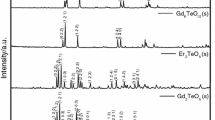Abstract
The standard Gibbs energies of formation of Nd2TeO6 and M6TeO12 (where M = Nd, Sm) were determined from vapour pressure measurements. The vapour pressure of TeO2(g) was measured by employing thermogravimetry-based transpiration technique. The temperature dependence of the vapour pressure of TeO2(g) over the mixtures Nd2TeO6+Nd6TeO12, generated by the incongruent vapourisation reaction, 3Nd2TeO6(s) → Nd6TeO12(s)+2TeO2(g)+O2(g), was measured in the temperature range 1,408–1,495 K. Similarly, the vapour pressure of TeO2(g) over the mixtures M6TeO12+M2O3 (where M = Nd, Sm), generated by the incongruent vapourisation reaction, M6TeO12(s) → 3M2O3(s)+TeO2(g)+½O2(g), was measured in the temperature range 1,703–1,773 and 1,633–1,753 K for Nd6TeO12(s) and Sm6TeO12(s), respectively. Enthalpy increments of M2TeO6(s) (where M = Nd, Sm) were determined by inverse drop calorimetric method in the temperature range 573–1,273 K. The thermodynamic functions, viz., heat capacity, entropy and free energy functions, were derived from the measured values of enthalpy increments. A mean value of −2,426.2 ± 0.6 and −2,417.9 ± 1.1 kJ mol−1 was obtained for \( \Updelta_{\text{f} } H_{298}^{\text{o}} \)(Nd2TeO6, s) and \( \Updelta_{\text{f}} H_{298}^{\text{o}} \)(Sm2TeO6, s), respectively, by combining the value of \( \Updelta_{\text{f}} G^{\text{o}} \)(Nd2TeO6, s) and \( \Updelta_{\text{f}} G^{\text{o}} \)(Sm2TeO6, s) derived from vapour pressure data and the free energy functions derived from the drop calorimetric data.












Similar content being viewed by others
References
Kleykamp H. Chemical states of the fission products in oxide fuels. J Nucl Mater. 1985;131:221–46.
Cordfunke EHP, Konings RJM. Chemical interaction in water cooled nuclear fuel: a thermochemical approach. J Nucl Mater. 1988;152:301–9.
Atanasova L, Dimitrova GB. Heat capacity and thermodynamic properties of tellurites Yb2(TeO3)3, Dy2(TeO3)3 and Er2(TeO3)3. J Therm Anal Calorim. 2012;107:809–12.
Gospodinov G, Atanasova L. Specific thermal and thermodynamic properties of the tellurites Fe2(TeO3)3, Fe2TeO5 and Fe2Te4O11. J Therm Anal Calorim. 2008;91:655–7.
Khadilkar HV, Bhojane SM, Kulkarni J, Kulkarni SG. Thermal properties of Na2TeO4(s) and TiTe3O8(s). J Therm Anal Calorim. 2013;111(1):939–42.
Pankajavalli R, Jain A, Babu R, Ananthasivan K, Anthonysamy S, Ganesan V. Thermodynamic characterization of lanthanum tellurate. J Nucl Mater. 2010;397:116–21.
Pankajavalli R, Jain A, Babu R, Anthonysamy S, Ananthasivan K, Ganesan V, Nagarajan K. Thermodynamic studies on Pr2TeO6. J Therm Anal Calorim. 2013;111:1609–14.
Pankajavalli R, Jain A, Sharma A, Anthonysamy S, Ganesan V. Thermodynamic investigation on M–Te–O (M = Sc, Y) system. J Therm Anal Calorim. 2013;112:83–93.
Jain A, Pankajavalli R, Babu R, Anthonysamy S, Ganesan V. Thermodynamic studies on Sn–Te–O system. J Therm Anal Calorim. 2013;112:109–16.
Aruna K, Dash S, Singh Z, Sen BK, Venugopal V. The standard molar Gibbs energy of formation of CeTe2O6(s) and R2TeO6(s) (R = La, Nd, Dy, Y). J Alloys Compd. 2010;496:20–4.
Pankajavalli R, Jain A, Anthonysamy S. In: Proceedings of International Symposium on Material Chemistry (ISMC-06). Mumbai, India; December 4–8, 2006; p. 101–2.
Balakrishnan S, Pankajavalli R, Ananthasivan K, Anthonysamy S. Thermodynamic stability of Sm2TeO6. Thermochim Acta. 2008;467:80–5.
Sreedharan OM, Dharwadkar SR, Chandrasekharaiah MS. BARC Report No. O-239; 1973.
Muenow DW, Hastie JW, Hauge R, Bautista R, Margrave JL. Vaporization, thermodynamics and structures of species in the tellurium+oxygen system. Trans Faraday Soc. 1969;65:3210–20.
Knacke O, Kubaschewski O, Hesselmann K. Thermochemical properties of inorganic substances. 2nd ed. Berlin: Springer; 1991.
Agarwal R, Singh Z. Enthalpy increments of Ba2Te3O8(s) and Ba3Te2O9(s) compounds. J Alloys Compd. 2006;414:230–4.
Chase MW. NIST-JANAF thermochemical tables. 4th ed. Gaithersburg: American Institute of Physics for the National Institute of Standards and Technology; 1998.
Hultgren R, Desai PD, Hawkins DT, Gleiser M, Kelley KK. Selected values of the thermodynamic properties of elements. Metals Park: American Society for Metals; 1973.
Author information
Authors and Affiliations
Corresponding author
Rights and permissions
About this article
Cite this article
Jain, A., Pankajavalli, R., Babu, R. et al. Thermodynamic studies on the systems M–Te–O (M = Nd, Sm). J Therm Anal Calorim 115, 1279–1287 (2014). https://doi.org/10.1007/s10973-013-3396-5
Received:
Accepted:
Published:
Issue Date:
DOI: https://doi.org/10.1007/s10973-013-3396-5




